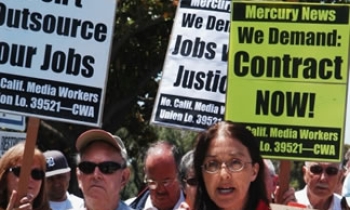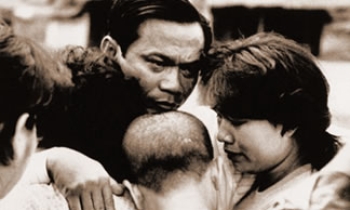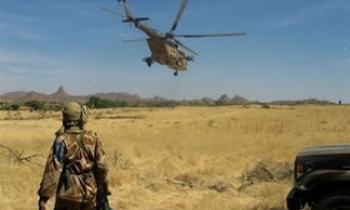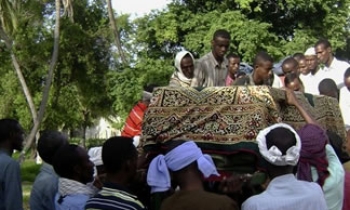SAGO, W. Va., Jan. 4 - The mistaken information last night that 12 of 13 miners trapped in a West Virginia coal mine had been saved, when in fact 12 were dead and only one was alive, came through a series of miscommunications among rescue workers and others exhausted from more than 30 hours of searching, and desperate for a good ending to a tragic situation, the president of the mining company said this afternoon.
"They were looking desperately for good information; they wanted to share it," said Bennett K. Hatfield, the chief executive of International Coal Group, the mine's owner, expressing regret that at the moment when the bodies and the one survivor were found, the strict communication protocols set up by officials to relay accurate information to the families seemed to fall by the wayside.
"I don't think anyone had a clue how much damage was about to be created," he said, his voice breaking several times in his presentation. "In the jubilation of the moment, the rules didn't hold."
He took some responsibility for not setting the record straight for two hours, saying company officials and state and federal authorities wanted to make sure of their facts about how many people had actually survived the explosion so as to not add to the families' grief.
"In the process of being cautious, we allowed the jubilation to go on longer than we should have," he said.
The body of one of the 13 miners was found earlier in the evening on Tuesday, near the scene of the explosion. He was identified as Terry Helms, the leader of the work crew.
But company officials have been facing criticism all day about why the families were told just before midnight, that all but one of the 12 men still trapped in the mine had been saved, when in fact the opposite was true. At 2:30 a.m., a grim-faced mining company official made the announcement of the deaths to a crowd of several hundred friends and relatives in a small nearby Baptist church.
What followed was pandemonium. "People who had been praising God a minute before were cursing," John Casto, a friend of the miners, told CNN in an interview.
But more fury was aimed at the mining executives for the false report and the long delay in its correction.
In his afternoon news conference, Mr. Hatfield provided a timeline about last night's events. The workers, he said, were operating several hundred feet below ground level and were communicating by radio and cell phones through oxygen masks that complicated clear understanding.
At 11:45 p.m. last night, he said, the mine rescue center received a report that 12 miners were alive. At 12:18 a.m., the rescue center received a report that the rescue workers and the "survivors" were leaving the area where they had been found.
"Company officials at the mine did not release any statements at this time," Mr. Hatfield said. "However, we were aware that numerous cell phone calls from a number of mine rescue workers and jubilant employees were made to family members and others upon receipt of this uplifting report."
At 12:30 a.m., when the rescue teams were at a place where they could breathe fresh air, "the mine command center was informed that there appeared to be only one survivor and that the others showed no vital signs," Mr. Hatfield said.
"The immediate reaction in the command center was that this report of only one survivor may be erroneous," he said.
"Many participants in the command center clinged to the fervent hope" that the others were "in some sort of comatose state and may be revivable," he said.
The one survivor, now known to be Randal McCloy Jr., 27, was taken immediately to a local hospital. Mr. Hatfield said he was in stable condition this afternoon.
He said that at 1:38 a.m. four additional rescue teams were dispatched along with emergency medical technicians to attend to the other miners. "Company and state officials did not believe it was prudent to issue a statement to family or the media without concrete information as to the actual status of the miners," he said.
At approximately 2 a.m., Mr. Hatfield said, "within minutes of learning that the initial reports were incorrect, state police officers were notified and asked to notify clergy that the initial reports may have been too optimistic."
He said that only some of the families were reached by those clergy.
The mine rescue teams were debriefed, "and company, state and federal officials became more convinced that the others were deceased."
By 2:30 a.m., he said, the company decided to announce the "devastating news," and "in keeping with our commitment, we went first to the church to tell the families, and then from there to the media center."
"We made what we believed to be the best decisions based on the information available while working under extreme stress and physical exhaustion," he said. "We sincerely regret the manner in which the events unfolded early this morning."
The word that 12 had been rescued and the somber correction brought a shocking end to a rescue effort that had dominated the airwaves since an explosion trapped the miners 260 feet below the surface early Monday morning.
President Bush expressed condolences this morning for the victims and their loved ones. He also praised Gov. Joe Manchin III, who had joined in the jubilation at the church, "for his compassion" and those involved in the rescue effort for their courage, but made no mention of the false report.
Governor Manchin also tried to emphasize the intensity of the rescue effort, rather than the misunderstandings that added to the tragedy. "I can only say there was no one who did anything intentionally but risk their lives to save their loved ones," he said in a televised interview.
The explosion was the state's deadliest mining disaster since one in 1968 that killed 78 men, including an uncle of Governor Manchin. Accidents deep underground and tense vigils above are woven into the history of the Appalachian region. Four years ago, nine coal miners were rescued in Pennsylvania after spending 77 hours trapped in a flooded mine.
Governor Manchin was at a loss this morning to explain how the false report of a rescue had spread.
"There was clearly some interpretation, some miscommunication," Mr. Manchin said in an interview with MSNBC.
He said he had been in a room next to the one in which family members were gathered at a nearby church when he heard a "roar" of jubilation. He was told that all the miners had been found alive, and was swept along in a sea of people as the church bells rang out. "Everyone was so euphoric," he said.
According to Mr. Manchin's aides, on his way to the command center the governor was asked "Is it a miracle?" and responded "Yes, miracles can happen." But while friends and family members who were at the scene last night said today that the governor had been part of the confusion, none of the abundant anger was directed at him.
The scene had been one of wild jubilation. "It's a miracle," said Loretta Ables, who said her fiancé, Fred Ware, was among the miners. "Everyone was telling us they were probably dead."
Terry Goff, a friend of one of the miners, said his hopes had been low after air samples taken from a hole drilled 260 feet into the mine had revealed extremely toxic carbon monoxide, a likely byproduct of the explosion.
"When they found the body and said the carbon monoxide levels were high, I doubted my faith," he said, "but now we've got 12 men walking off that hill."
Mr. Casto said a man had come running into the church and suddenly people were shouting that there had been a miracle and all 12 had been saved.
Details quickly followed that lent the report even more credence, Mr. Casto said. "We were told that ambulances would bring them to the church," he said, and relatives were told they would be able to talk to the miners before they were taken to a hospital.
Some witnesses told The Associated Press that the ambulance removing Mr. McCloy seemed to bear out the good news.
Spirits remained high even as the time dragged on with no other miners arriving, Mr. Casto said.
"We waited and waited," he said. "Loved ones and families stood out on the porch wrapped in blankets waiting for their fathers or brothers to come up and give them a hug."
Then a group of mining officials arrived along with state police officers, said Mr. Casto. One man from the mining company walked to a podium in the church. "I told you I was going to tell you the truth, and I'm going to tell you the truth now, and there's one survivor," Mr. Casto recalled him saying.
Mr. Manchin said that after the first report he repeatedly asked the officials he was with whether the information had been confirmed, and that he had gone to the command center to seek more information. "When we got to the command center, they were ecstatic too," he told CNN.
He said the mistake might have been the result of different teams going in and out of the mine, since their stints were limited for safety reasons.
"We knew from the first that the odds were against us," Mr. Manchin said. "We were hoping for 13 miracles, and now we're still clinging to one miracle."
At the morning briefing, Mr. Hatfield said that the miners who died had made a "textbook" effort to survive. They barricaded themselves at the end of the corridor in which they were trapped, using sheets of laminated fabric to try to create a shield to keep out the poisoned air.
This afternoon, Dr. Lawrence Roberts, a doctor involved in Mr. McCloy's care at West Virginia University's Ruby Memory Hospital in Morgantown, said the miner had briefly come out of sedation and had responded to his wife. A lung that had collapsed has re-expanded, the doctor said, but because of the effects of dehydration the kidneys were not functioning properly and Mr. McCloy would be put on blood dialysis.
"In most respects, I think he's making progress, as we would expect," Dr. Roberts said. "It's only been a few hours since I last spoke, but I think there's been progress in the right direction."
This morning at The Donut Shop in nearby Buckhannon, a waitress, Brenda McCormick, said, "People are down and they're very glum."
Since the explosion the shop's roadside sign had read: "Prayers and Wishes for Our Miners and Their Families."
At daylight today, it was changed to read: "Only One Miracle."
James Dao reported from Sago, W. Va., for this article, and John O'Neil reported from New York. Brenda Goodman contributed reporting from Atlanta, and Gardiner Harris from Washington.









